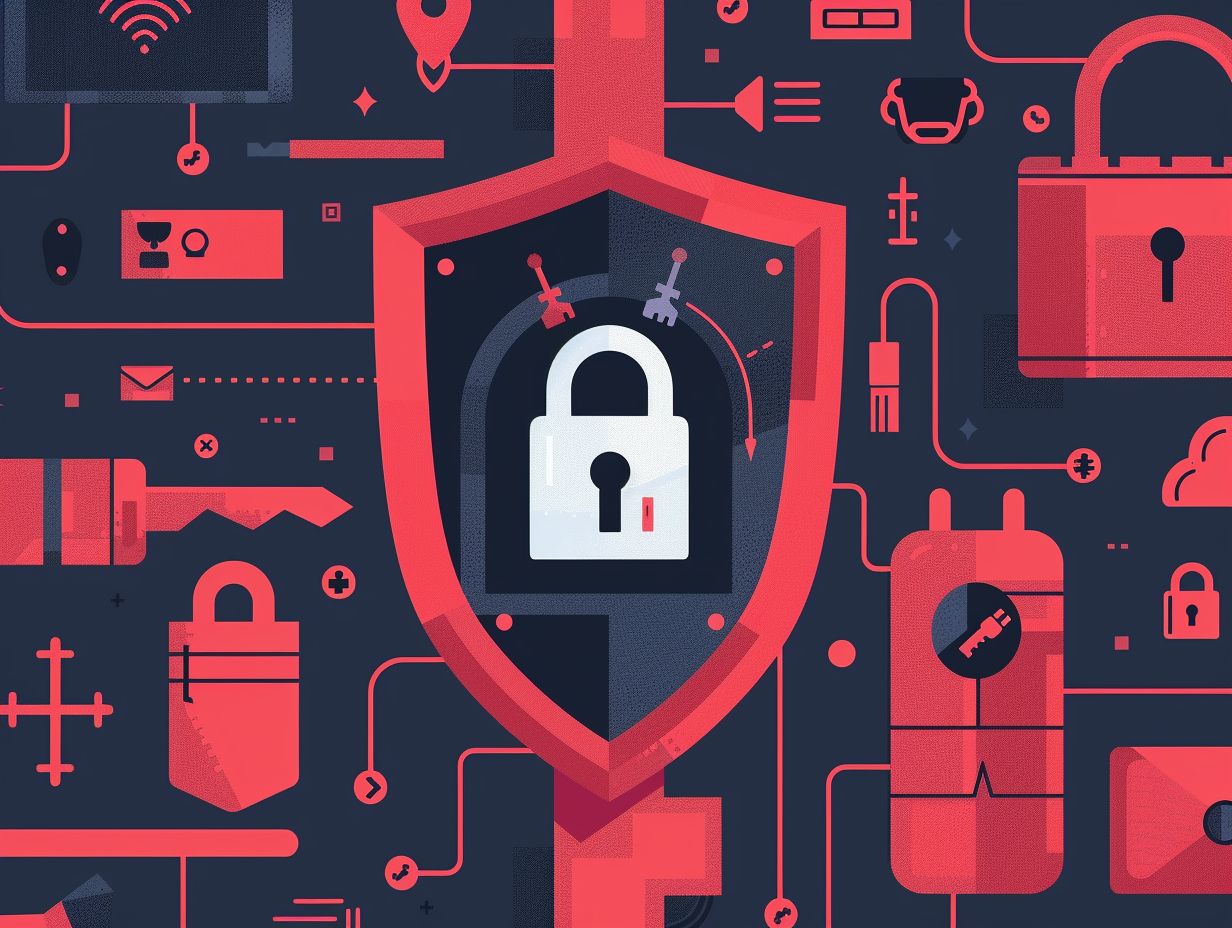In today’s digital age, cybersecurity is of utmost importance. This article will provide you with an overview of Cisco Security Solutions, with a particular focus on Threat Defense.
You will delve into understanding Threat Defense, explore the components of Cisco Security Management, such as Firewalls and Intrusion Prevention Systems. Additionally, we will discuss the benefits of utilizing Cisco Security Management to enhance security and operational efficiency.
Best practices and tips for successfully implementing Cisco Security Management will be shared with you. Take the opportunity to learn more about protecting your digital assets with Cisco Security Solutions.
Key Takeaways:

Overview of Cisco Security Solutions
Cisco Security Solutions offer a range of state-of-the-art products and services designed to protect networks, data, and systems from cyber threats. These solutions are integrated into the Cisco Security Management Center to provide centralized control and visibility across the security infrastructure.
One of the key offerings includes Cisco’s Threat Defense solutions, which leverage advanced threat intelligence and analytics to proactively detect and mitigate potential security risks. Cisco Firewalls are essential for establishing secure boundaries and monitoring network traffic to prevent unauthorized access. Cisco’s Intrusion Prevention systems further enhance security by identifying and blocking threats in real-time, ensuring that networks remain resilient against evolving cyber threats.
Cisco Threat Defense
You can rely on Cisco Threat Defense, a comprehensive security solution that integrates advanced threat detection, endpoint protection, and policy enforcement mechanisms to protect networks from evolving cyber threats. It seamlessly integrates with other Cisco security products to establish a unified defense strategy.
With its robust threat detection capabilities, Cisco Threat Defense can effectively identify and mitigate various security breaches such as malware, ransomware, and phishing attacks. The endpoint security features ensure that all network-connected devices remain shielded from potential threats, while the policy enforcement mechanisms help in enforcing security policies throughout the network infrastructure. By utilizing real-time threat intelligence and machine learning algorithms, Cisco Threat Defense continually adjusts to new threats, positioning it as a proactive defense solution in the dynamic cybersecurity landscape.
Understanding Threat Defense
An important feature of Cisco Threat Defense is its strong policy enforcement capabilities, ensuring that network access control policies are consistently applied to mitigate potential vulnerabilities and intrusions. This solution offers improved visibility into network traffic and security events, enabling proactive threat detection and response.
The integration with intrusion prevention systems further enhances the overall security posture by actively monitoring and blocking potential threats before they can compromise the network defenses. Through real-time analysis of network activities, Cisco Threat Defense can detect anomalies and suspicious behavior, triggering immediate alerts and automated responses to defend against cyberattacks. This level of policy management enables organizations to uphold a secure environment while effectively managing their network resources.
Components of Cisco Security Management

Your Cisco Security Management system consists of a suite of components, such as advanced Firewalls, Next-Generation Intrusion Prevention Systems (NGIPS), and Security Management Center, which work collaboratively to provide comprehensive security measures and centralized security management.
The Firewalls in the Cisco Security Management system serve as the primary defense line, overseeing and controlling incoming and outgoing network traffic according to predefined security rules.
Next-Generation Intrusion Prevention Systems (NGIPS) are instrumental in identifying and preventing malicious activities within the network, offering advanced threat detection capabilities.
The Security Management Center acts as the central control hub for monitoring and managing security policies throughout the entire network, delivering real-time insights and actionable intelligence to security teams for effective threat response and mitigation.
Firewalls, Intrusion Prevention Systems, and More
Firewalls and NGIPS are integral components of Cisco Security Management, providing advanced threat detection capabilities, seamless integration with security policies, and efficient enforcement of access control measures. These technologies play a crucial role in protecting networks from malicious activities.
Firewalls serve as a protective barrier between the internal network and external threats, scrutinizing incoming and outgoing traffic to prevent unauthorized access and safeguard sensitive data. On the other hand, NGIPS offer in-depth inspection of network traffic, detecting and blocking potential threats in real-time.
Through collaborative efforts, Firewalls and NGIPS ensure consistent enforcement of network security policies, enabling organizations to proactively address evolving cyber threats and mitigate the likelihood of security breaches. This synergistic relationship between Firewalls and NGIPS enhances the overall security posture of an organization’s network infrastructure.
Benefits of Using Cisco Security Management
By utilizing Cisco Security Management, you can access an array of benefits such as enhanced scalability to meet evolving security requirements, improved regulatory compliance with robust security measures, and streamlined incident response capabilities. This enables organizations to achieve higher operational efficiency and mitigate risk exposure effectively.
Deploying Cisco’s CCNP Security solutions allows companies to establish a centralized view of their security landscape, facilitating quick identification and mitigation of potential threats. This comprehensive approach bolsters overall security posture and supports proactive threat management.
Utilizing automation and orchestration features, you can enhance productivity, reduce manual errors, and realize cost savings while improving resource allocation. The detailed reporting and analytics offered by Cisco Security Management solutions give the power to organizations to make informed decisions and optimize security strategies for long-term success.
Improved Security and Efficiency
Enhanced security and operational efficiency become core outcomes when you deploy Cisco Security Management solutions. The centralized Management Center allows for the automation of security processes, real-time monitoring of network health and performance, and rapid incident response capabilities.
This integrated approach streamlines security management tasks, enabling security teams like yours to efficiently identify and address potential threats. By utilizing advanced analytics and machine learning algorithms, the system can proactively detect anomalies and suspicious activities, thereby enhancing overall threat visibility.
The Management Center acts as a central hub for orchestrating security policies across your network, ensuring consistent enforcement and compliance. With continuous monitoring and reporting, your organization can proactively stay ahead of evolving cyber threats and respond promptly to security incidents.
Implementing Cisco Security Management

Successfully implementing Cisco Security Management involves meticulous deployment planning, precise configuration of security policies, and proactive troubleshooting measures to ensure seamless integration and optimal performance. Following best practices is paramount for a successful implementation.
By carefully analyzing your network requirements and conducting a thorough risk assessment, you can tailor the security management deployment strategy to fit the specific needs of your organization. Configuration best practices include maintaining up-to-date software patches, enforcing strong access controls, implementing secure authentication mechanisms, and regularly monitoring and analyzing security logs for potential threats.
Your troubleshooting techniques should encompass analyzing system logs, conducting regular security audits, and staying informed about the latest cyber threats and vulnerabilities to effectively mitigate security risks.
Best Practices and Tips for Successful Implementation
Implementing Cisco Security Management in your organization requires adherence to best practices, such as regular software upgrades, proactive policy management, and seamless integration with your existing network infrastructure. It is crucial to ensure compatibility and scalability for a successful deployment.
Regularly updating the software of Cisco Security Management solutions is essential to patch vulnerabilities and enhance security measures. By staying up-to-date with the latest releases and patches, you can ensure that your systems are fortified against emerging threats. Effective policy management involves defining clear guidelines, access controls, and monitoring procedures to maintain a secure environment. Your integration strategies should focus on harmonizing security tools with other network components to create a cohesive defense mechanism. Scalability considerations involve planning for future growth and ensuring that the security solution can adapt to evolving needs.
Frequently Asked Questions
What is Cisco Security Management and Threat Defense?
Cisco Security Management and Threat Defense is a comprehensive approach to network security that combines Cisco’s advanced security technologies and solutions to proactively defend against threats and secure critical systems and data.
What are the key components of Cisco Security Management and Threat Defense?

The key components of Cisco Security Management and Threat Defense include network and endpoint security, identity and access control, threat intelligence and response, and security analytics and reporting.
How does Cisco Security Management and Threat Defense protect against cyber threats?
Cisco Security Management and Threat Defense utilizes a multi-layered approach to security that includes continuous monitoring, threat detection, and threat response capabilities to protect against a wide range of cyber threats such as malware, ransomware, and phishing attacks.
Can Cisco Security Management and Threat Defense be customized for different industries and business needs?
Yes, Cisco Security Management and Threat Defense offers a range of solutions and services that can be tailored to meet the specific security requirements of different industries and business needs.
How does Cisco Security Management and Threat Defense ensure compliance with regulatory standards?
Cisco Security Management and Threat Defense offers compliance management capabilities that can help organizations meet regulatory requirements and standards such as PCI DSS, HIPAA, and GDPR.
Is it possible to integrate Cisco Security Management and Threat Defense with other security solutions?
Yes, Cisco Security Management and Threat Defense is designed to work seamlessly with other security solutions and can be integrated with third-party technologies to provide a comprehensive and coordinated defense against cyber threats.
